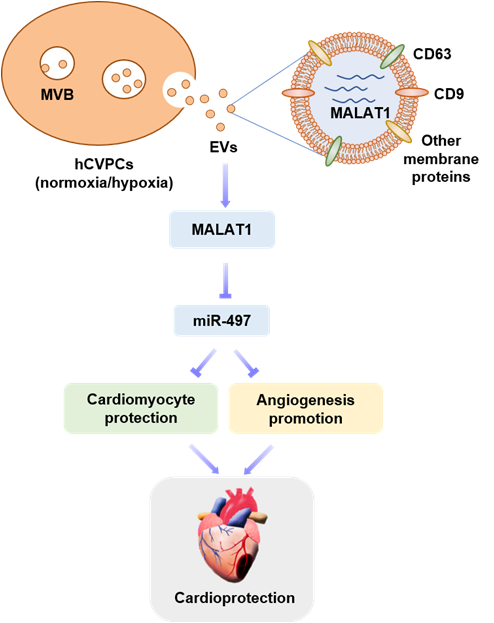
Myocardial infarction (MI), characterized by massive cardiomyocyte death followed by cardiac dysfunction and myocardial fibrosis, is a leading cause of death worldwide. Endogenous myocardial protective systems can be triggered by injurious stimuli to reduce cardiomyocyte death and promote proliferation of preexisting cardiomyocytes but they are insufficient for cardiac repair. Therefore, developing new therapeutic strategies to promote the infarct healing by reducing cardiomyocyte death following acute MI (AMI) and improving the cardiac performance are desirable.
Cell therapy by transplantation of stem/progenitor cells and their derived cardiovascular cells is one of the most notable alternative therapeutic approaches under exploration. Previous studies by Dr. YANG Huangtian's team from Shanghai Institute of Nutrition and Health of the Chinese Academy of Sciences and others showed that human pluripotent stem cells (hPSCs)-derived cardiovascular progenitor cells (CVPCs) are a promising source for myocardial repair, while the mechanisms remain largely unknown.
In a study published online in Cell Death & Disease on May 11, Dr. YANG’s team and the collaborators revealed the cardioprotective effects of the extracellular vesicles (EVs) secreted from human embryonic stem cells (hESC)-derived CVPCs (hESC-CVPCs), referred to as hCVPC-EVs, under normoxic (EV-N) and hypoxic (EV-H) conditions in the infarcted heart and the long non-coding RNA (lncRNA)-related mechanisms.
The researchers found that the injection of hCVPC-EVs into acutely infracted murine myocardium significantly improves the cardiac function and reduces fibrosis at day 28 post-MI, which is accompanied with the improved vascularization and cardiomyocyte survival at border zones. Consistently, hCVPC-EVs enhance the tube formation and migration of human endothelial cells (ECs), and improve the cell survival of neonatal rat cardiomyocytes (NRCMs) with oxygen glucose deprivation (OGD) injury.
Besides, they found that the improvement of the EV-H in cardiomyocyte survival and tube formation of ECs is significantly better than those in the EV-N. RNA-seq analysis revealed a high abundance of the lncRNA MALAT1 in the EV-H. The abundance is upregulated in the infarcted myocardium and cardiomyocytes treated with hCVPC-EVs. Overexpression of human MALAT1 improves the cell viability of NRCM with OGD injury, while knockdown of MALAT1 inhibites the hCVPC-EV-promoted tube formation of ECs. Luciferase activity assay, RNA pull-down, and manipulation of miR-497 levels showed that MALAT1 improves NRCM survival and EC tube formation through targeting miR-497.
These findings revealed that hCVPC-EVs promote the infarct healing through the improvement of cardiomyocyte survival and angiogenesis and the cardioprotective effects of hCVPC-EVs can be enhanced by hypoxia-conditioning of hCVPCs and are partially contributed by MALAT1 via targeting the miRNA.
This study provides new insights into the cardioprotective mechanisms of hCVPCs and the cell-secreted EVs, and suggest that hCVPC-EVs might be used as an approach to understand the mechanism of infarct healing and promote healing of infarcted hearts.

Schematic representation of the therapeutic effect and mechanisms of hCVPC-secreted extracellular vesicles in the infarcted hearts. (Image by Dr. YANG Huangtian’s team)

86-10-68597521 (day)
86-10-68597289 (night)

52 Sanlihe Rd., Xicheng District,
Beijing, China (100864)

